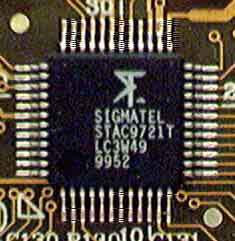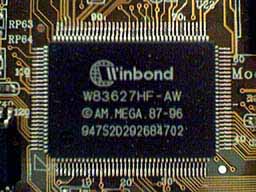Transcend TS-ASL3 Socket-370 i815E ATX
by Henry Kuo on October 27, 2000 12:20 AM EST- Posted in
- Motherboards
There are three DIMM slots on the TS-ASL3, supporting up to 512MB SDRAM. The i815E chipset has some strange memory limitations that we’ll recap here. Not only is the 512MB SDRAM limit not enough for some users, the type of memory users can put in is also restricted. To most users, 512MB is probably more than enough now, but this might not be the case in the near future. Moreover, 512MB is not considered enough for a many workstation or server applications. More importantly, if you want to use PC133 SDRAM, only the first two DIMM slots can be populated according to the official specs from Intel. If you want to use all three DIMM slots, the memory will have to run in PC100 mode. So far the ASUS CUSL2 is the only i815E solution we have tested that can run all three DIMMs in PC133 mode without sacrificing stability.
In order to make sure the TS-ASL3 is stable, Transcend put a total of fifteen 1500uF capacitors around the CPU socket. That's probably a big part of why the board was rock solid during our stability tests. Unfortunately, some of the capacitors are quite close to the socket; slightly larger heatsink units should be ok, but users with very large heatsink units may run into trouble. It also implies that the oversized FC-PGA-C heatsinks, which are required for 1GHz and above processors, will not work on this motherboard.
Below the PCI slots you’ll find the 82810BA I/O Controller Hub 2 (ICH2), which is what differentiates the i815E chipset from the i815 chipset. The i815 chipset, which uses the 82810AA ICH1, only has Ultra ATA 66 support. The 82810BA ICH2 not only features Ultra ATA 100 support, but also a second USB controller and an Intel 82559 network controller. There are two IDE channels on the board allowing up to 4 IDE devices (2 devices per channel). The second USB controller allows two more USB devices on top of the original two. The original USB connectors are located at the back of the I/O panel, while Transcend puts the extra two USB connectors on the left side of the motherboard. However, Transcend does not include the necessary USB bracket to take advantage of those USB ports, so users will have to get their own brackets if they want to connect more than two USB devices.
Just like most i815E solutions we have seen, the TS-ASL3 features the 6/0/1/1 (PCI/ISA/CNR/AGP) expansion slot configuration, which is pretty much all you can ask for today. The CNR slot is shared with the sixth PCI slot. The integrated network controller supports 10Mbps Home PNA 2.0 or 10/100 Ethernet depending on the CNR card that is plugged in. However, currently we only see a handful of suppliers on CNR cards, which is unfortunate because the 82559 network controller is quite good and the CNR cards are relatively cheap.
Since one serial port is replaced by the VGA connector on the I/O panel, Transcend put the second serial port connector on the upper left hand corner of the TS-ASL3. Transcend does provide the bracket for the second serial port. The TS-ASL3 uses the Sigmatel STAC9721T AC'97 CODEC as their on-board sound solution. This can provide some basic sound for users, but for those who are serious about sound, they should definitely go for a hardware-based PCI sound card. Make sure to read our Speaker Buyer’s Guide as well as our growing collection of Sound and Speaker reviews.

The TS-ASL3 uses the Award Modular BIOS 6.00PG, which features the Jumperless CPU setup function. Users can go to the Voltage / Frequency section to adjust the FSB settings. The settings available vary with the speed of the processor running. If you set the CPU to run at 66MHz FSB, the FSB settings available are 66 – 99MHz in 1MHz increments. If the CPU is running at 100MHz FSB, the values available are 100 – 132MHz in 1MHz increments. If you have a CPU running 133MHz FSB, you will be able to choose any FSB speed between 133MHz and 166MHz in 1MHz increments.
These limitations can be justified, since usually you can’t usually push your processor too far off the default FSB. But hardware enthusiasts always want to have access to all settings. Transcend knows that, so they have a set of jumpers on the motherboard, which allow users to manually set the default FSB for the CPU. So if you have a CPU running 100MHz, but you want to try 135MHz FSB with some specially cooling, you can set those jumpers to 133MHz, and then go into the BIOS and set the FSB to 135MHz. This method might be a bit tedious, but that means you can have FSB settings all the way from 66MHz to 166MHz in 1MHz increments, allowing you to squeeze the last bit of juice out of the CPU.
Transcend also put in the feature for users to change the core voltage for the CPU. Users can set the voltage to be +0.05 / +0.1 / +0.2 / +0.3 / +0.4 / -0.05 / -0.1 Volts from the default voltages. Pushing your CPU more than 0.4V above the default is generally considered a bad idea so these settings should be sufficient for just about any overclocking endeavor.
Just like most other i815E solution, the TS-ASL3 uses the Winbond W83627HF-AW Super I/O chip with Hardware Monitoring. You can go to the PC Health panel in the BIOS and see the temperature of the CPU and the system. There are a total of three fan connectors on the board, including the one for the HSF unit, and users can read the speed of all three of them under the PC Health panel. It also shows the core voltage for the CPU, but nothing about the AGP voltage.

Transcend also puts an IrDA-Compliant infrared module connector on the TS-ASL3, between the fourth and fifth PCI slot. Using this module, a Standard IR device, and application software such as Laplink or Win98 Direct Cable Connection, users can transfer files to and from laptops and PDA’s. Transcend also provides users with an option to use a Consumer Infrared (CIR) set for both wireless transmitting and remote control functions through one external infrared module.
The manual for the TS-ASL3 contains detailed information on all the jumpers and connectors. However, it still lacks instructions for first time users on how to install the motherboard. It also contains details on the BIOS settings, so users can play with the BIOS to optimize their systems. Moreover, it provides decent information on installing the drivers and video software. Unlike most motherboard manufacturers, Transcend does not provide any special software bundle with the TS-ASL3.










0 Comments
View All Comments